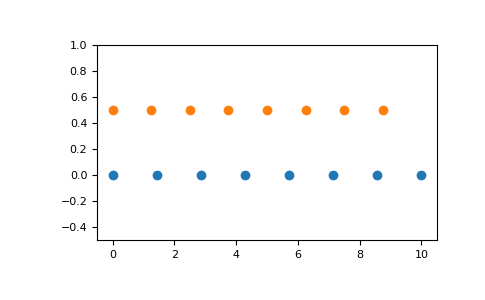- ubuntu12.04环境下使用kvm ioctl接口实现最简单的虚拟机
- Ubuntu 通过无线网络安装Ubuntu Server启动系统后连接无线网络的方法
- 在Ubuntu上搭建网桥的方法
- ubuntu 虚拟机上网方式及相关配置详解
CFSDN坚持开源创造价值,我们致力于搭建一个资源共享平台,让每一个IT人在这里找到属于你的精彩世界.
这篇CFSDN的博客文章numpy.linspace函数具体使用详解由作者收集整理,如果你对这篇文章有兴趣,记得点赞哟.
numpy.linspace(start, stop, num=50, endpoint=True, retstep=False, dtype=None) 。
在指定的间隔内返回均匀间隔的数字.
返回num均匀分布的样本,在[start, stop].
这个区间的端点可以任意的被排除在外.
。
| Parameters(参数): | 。 start : scalar(标量) 。
stop : scalar 。
num : int, optional(可选) 。
endpoint : bool, optional 。
retstep : bool, optional 。
dtype : dtype, optional 。
|
|---|---|
| Returns: | samples : ndarray 。
step : float(只有当retstep设置为真的时候才会存在) 。
|
。
See also 。
arange 。
Similar to linspace, but uses a step size (instead of the number of samples) 。
.arange使用的是步长,而不是样本的数量 。
logspace 。
Samples uniformly distributed in log space. 。
当endpoint被设置为False的时候 。
|
1
2
3
4
5
6
7
8
|
>>>
import
numpy as np
>>> np.linspace(
1
,
10
,
10
)
array([
1.
,
2.
,
3.
,
4.
,
5.
,
6.
,
7.
,
8.
,
9.
,
10.
])
>>> np.linspace(
1
,
10
,
10
, endpoint
=
False
)
array([
1.
,
1.9
,
2.8
,
3.7
,
4.6
,
5.5
,
6.4
,
7.3
,
8.2
,
9.1
])
In [
4
]: np.linspace(
1
,
10
,
10
, endpoint
=
False
, retstep
=
True
)
Out[
4
]: (array([
1.
,
1.9
,
2.8
,
3.7
,
4.6
,
5.5
,
6.4
,
7.3
,
8.2
,
9.1
]),
0.9
)
|
官网的例子 。
Examples 。
|
1
2
3
4
5
6
|
>>> >>> np.linspace(
2.0
,
3.0
, num
=
5
)
array([
2.
,
2.25
,
2.5
,
2.75
,
3.
])
>>> np.linspace(
2.0
,
3.0
, num
=
5
, endpoint
=
False
)
array([
2.
,
2.2
,
2.4
,
2.6
,
2.8
])
>>> np.linspace(
2.0
,
3.0
, num
=
5
, retstep
=
True
)
(array([
2.
,
2.25
,
2.5
,
2.75
,
3.
]),
0.25
)
|
Graphical illustration
|
1
2
3
4
5
6
7
8
9
10
11
12
|
>>> >>>
import
matplotlib.pyplot as plt
>>> N
=
8
>>> y
=
np.zeros(N)
>>> x1
=
np.linspace(
0
,
10
, N, endpoint
=
True
)
>>> x2
=
np.linspace(
0
,
10
, N, endpoint
=
False
)
>>> plt.plot(x1, y,
'o'
)
[<matplotlib.lines.Line2D
object
at
0x
...>]
>>> plt.plot(x2, y
+
0.5
,
'o'
)
[<matplotlib.lines.Line2D
object
at
0x
...>]
>>> plt.ylim([
-
0.5
,
1
])
(
-
0.5
,
1
)
>>> plt.show()
|

以上就是本文的全部内容,希望对大家的学习有所帮助,也希望大家多多支持我.
原文链接:https://www.cnblogs.com/antflow/p/7220798.html 。
最后此篇关于numpy.linspace函数具体使用详解的文章就讲到这里了,如果你想了解更多关于numpy.linspace函数具体使用详解的内容请搜索CFSDN的文章或继续浏览相关文章,希望大家以后支持我的博客! 。
我遇到了 np.linspace() 的问题,我不知道为什么它会这样。我的代码如下所示: x = linspace(0, 6, 3) print 'x = ', x # prints the
我正在尝试编写一个类似版本的 python 的 numpy.linspace 函数。 double linspace(int a, int b, int c){ double line[c];
如下所示: ? 1
我有一个像这样的 Pandas 数据框 a b c 0 0.5 10 7 1 1.0 6 6 2 2.0 1 7 3 2.5 6 -5 4 3.5 9
我想生成 0 到 1 之间均匀间隔的 50 个数字 首先,我尝试使用 numpy.arange(0,1,0.02),下面是我得到的输出。 [0. 0.02 0.04 0.06 0.08 0.1
我想生成一个 n x 3 矩阵,其中 n 是像素数(宽 * 高)。 x = linspace(-1, 1, width) y = linspace(-1, 1, height) r = 1.0 vie
在我的项目中,编译器提示以下(以及许多其他类似的)代码片段: Eigen::ArrayXf window = Eigen::ArrayXf::LinSpaced(2*M
我有一组想要执行的方程: x = np.linspace(0, 2, 3) y = np.linspace(x, x+2, 3) 然后我想用一个计算来填充二维数组: a = 2*x + y 例如,给定
我有一个带有直方图的函数,绘制如下: import matplotlib.pyplot as plt import numpy as np lin = np.linspace(min(foo), ma
我正在尝试在 for 循环中使用 linspace。我想要 0 到 10 之间的 0.5 间隔。看来 z_bin 正在正确执行。 我的问题:如何在 for 循环中正确使用 linspace 来代替注释
所以我对 linspace 有点问题。我想生成一个数字数组,例如: [0.000001, 0.00001, 0.0001 , 0.001 ,0 .01 , 0.1] 所以我尝试了以下代码: alpha
我希望有一个生成器函数,它返回一条线上的点,给定一个最小距离 k。这很简单,可以使用 numpy 完成,如下所示: points = np.linspace(start, end, k) 但是,我想生
这个问题已经有答案了: How to avoid floating point errors? [duplicate] (2 个回答) 已关闭 4 年前。 我正在尝试使用linspace等间隔闭区间。
使用 MATLAB,我想在数组中的每个点之间进行线性插值。 使用 interpolate 将以非线性方式进行。我想做的是类似于产生低通滤波器系数。 我想出了一个解决方案,但我想避免使用 for 循环:
我一直在研究一种在并行处理中反转拉普拉斯变换的算法(即同时积分 s 空间中的多个拉普拉斯函数),但我知道一个事实,即并行处理不是问题,因为实现此方法是为了解决问题。但问题仍然存在,本质上我的代码一遍又
这样写有什么好处吗 t = linspace(0,20,21) 结束 t = 0:1:20 ? 我理解前者产生一个向量,就像第一个一样。 谁能告诉我 linspace 在 t = 0:1:20 上有用
我对 python 很陌生,在使用 linspace 例程绘制高斯函数图时遇到困难。 (我不想使用 numpy)。 """plot a normalized gaussian function """
这个问题已经有答案了: Use of None in Array indexing in Python (2 个回答) 已关闭 7 年前。 我读过一段代码是这样的 x = np.linspace(0,
np.linspace(10**3, 10**6, num=5, dtype=np.int16) 产量 array([ 1000, -11394, -23788, 29354, 16960],
有人可以用 numpy.linspace 解释这个舍入问题吗? import numpy as np np.linspace(0, 1, 6) == np.around( np.linspace(0,

我是一名优秀的程序员,十分优秀!